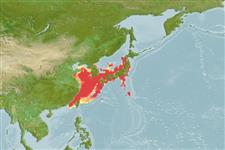分类 / Names
俗名 | 同种异名 | Catalog of Fishes(属, 种) | ITIS | CoL | WoRMS | Cloffa
Elasmobranchii
板鳃亚纲 (鲨鱼与 鱼) (sharks and rays) >
Pristiophoriformes (Saw sharks) >
Pristiophoridae (Saw sharks)
Etymology: Pristiophorus: pristio-, presumably derived from prio (Gr.), to saw, but treated here as a noun (a saw); phorus, from phoreus (Gr.), bearer or carrier, referring to saw-like snout (note also that pristis is Greek for sawfish). (See ETYFish); japonicus: -icus (L.), belonging to: Japan, where type locality (not specified) is situated. (See ETYFish).
More on author: Günther.
Environment: milieu / climate zone / depth range / distribution range
生态学
海洋 居于水底的; 深度上下限 0 - 500 m (Ref. 54710). 深水域; 48°N - 22°N, 118°E - 145°E (Ref. 54710)
Northwest Pacific: Japan, Korea, northern China. Does not occur in the Western Central Pacific (Ref. 31368).
西北太平洋: 日本,韓國,中國北部。 不會出現在中西太平洋.(參考文獻 31368)
大小 / 重量 / 年龄
Maturity: Lm ? range ? - ? cm
Max length : 136.0 cm TL (female)
Pristiophorus japonicus has a long, narrow, and narrowly tapering rostrum (rostrum length is 26-29% of TL), distance from rostral tip to barbels about equal or slightly greater than distance from barbels to mouth (1:1.1-1.2); distance from rostral barbels to nostrils about equal to distance from nostrils to 1st gill slits. About 15-26 large rostral teeth on each side of the rostrum in front of the barbels, 9-17+ behind them; distance from mouth to nostrils 1.1-1.2 times internarial space. Tooth rows 34-58 in upper jaw. Dorsal and pectoral fins covered with denticles in large specimens. Lateral trunk denticles largely unicuspidate. First dorsal fin origin behind free rear tips of pectorals by eye length or more (Ref. 247).
Caudal fin almost straight, with slender upper and lower lobes; pectoral well developed but are not ray-like (Ref. 6871).
日本锯鲨[Pristiophorus japonicus] 有一个长的,狭窄的,与狭窄尖端细的喙 (喙长度是 26-29% 的 TL) ,从嘴的顶端到触须的距离大约相等或些微大于从触须到嘴 (1:1.1-1.2) 的距离; 从嘴的触须到鼻孔的距离大约等于从鼻孔到第一鳃缝的距离。 大约 15-26 大的嘴在触须之前牙齿在喙的两边, 在他们后面的 9-17+; 距离从嘴巴到鼻孔 1.1-1.2 倍于鼻孔间隙。 在上颌中的齿列 34-58。 背部的与胸鳍在大的个体中覆盖着细齿了。 侧面的躯干细齿相当单尖端。 第一背鳍起点在眼径或更多的胸鳍的鳍游离后端后面。 (参考文献 247)
尾鳍几乎直的, 有细长的上叶与下叶; 胸的发展良好的但是不是像鳍条一样的.(参考文献 6871)
Lives on continental shelves and upper slopes on or near the bottom. Also found in coastal waters on sand or mud bottoms. Feeds on small bottom organisms using its barbels to poke the bottom with its snout. Ovoviviparous, with 12 young in a litter.
生活在大陆架与上层斜坡在底部上面或附近。 也发现于沿岸水域的砂上或泥底。 吃使用它的触须拨开底部的小的底部生物用它的吻。 卵胎生的, 具有 12 幼鱼在一胎。
Life cycle and mating behavior
成熟度 | 繁殖 | 产卵场 | 卵 | 孕卵数 | 仔鱼
Ovoviviparous, embryos feed solely on yolk (Ref. 50449).西北太平洋: 日本,韓國,中國北部。 不會出現在中西太平洋.(參考文獻 31368)
Compagno, L.J.V., 1984. FAO Species Catalogue. Vol. 4. Sharks of the world. An annotated and illustrated catalogue of shark species known to date. Part 1 - Hexanchiformes to Lamniformes. FAO Fish. Synop. 125(4/1):1-249. Rome, FAO. (Ref. 247)
人类利用
渔业: 商业性
更多信息
参考文献养殖养殖信息品种遗传学Electrophoreses遗传率疾病加工NutrientsMass conversion
工具
特别资料
下载 XML
网络资源
Estimates based on models
Preferred temperature (Ref.
123201): 7.7 - 21.8, mean 17.4 °C (based on 199 cells).
Phylogenetic diversity index (Ref.
82804): PD
50 = 0.5156 [Uniqueness, from 0.5 = low to 2.0 = high].
Bayesian length-weight: a=0.00389 (0.00180 - 0.00842), b=3.12 (2.94 - 3.30), in cm total length, based on all LWR estimates for this body shape (Ref.
93245).
营养阶层 (Ref.
69278): 3.8 ±0.58 se; based on food items.
回复力 (Ref.
120179): 低的, 最小族群倍增时间4.5 - 14 年 (Fec=12).
Fishing Vulnerability (Ref.
59153): Very high vulnerability (82 of 100).
